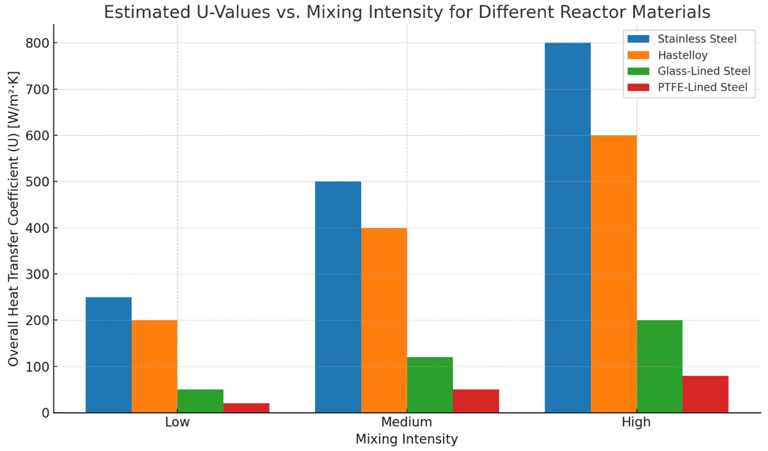
Heat Transfer Efficiency of Reactor Construction Materials
Efficient heat transfer is a cornerstone of safe and effective reactor design. It directly influences reaction rates, selectivity, energy consumption, and temperature control. One of the key drivers of heat transfer efficiency is the thermal conductivity of the reactor wall material, which governs how well heat is transferred between the process fluid and the utility (usually via a jacket or internal coils).
This section compares commonly used reactor construction materials — Stainless Steel, Hastelloy, Glass-Lined Steel, and PTFE-Lined Steel — in terms of their heat transfer efficiency, focusing on thermal conductivity and overall heat transfer coefficient (U-value).
Material Comparison by Thermal Conductivity
Let’s compare the four materials which are normally used to build chemical reactors:
Interpretation:
Higher thermal conductivity = better inherent heat transfer through the wall.
Lower conductivity = higher temperature gradients, requiring higher jacket temperatures, longer residence times, or larger surface areas.
Key Heat Transfer Terms
Thermal Conductivity (k): Material's ability to conduct heat (W/m·K).
Overall Heat Transfer Coefficient (U): Total effectiveness of the system to transfer heat, considering internal/external films and the wall. Units: W/m²·K.
U depends on:
Wall conductivity (k)
Internal and external film coefficients (hᵒ and hₒ)
Wall thickness (t)
Fouling or scaling
Typical U-Values in Jacketed Reactors
💡 Practical Considerations
Impact of Low U-Value on Cooling Performance
In exothermic reactions, poor heat transfer can create hot spots, temperature overshoots, or even thermal runaway. Low-U materials require:
Larger surface areas
Higher coolant flows
Greater driving force (∆T)
Longer cooling times
Quantitative Comparison: Cooling Capacity
The overall heat transfer coefficient (U) directly governs how effectively heat can be removed from a reaction mixture. It appears in the core equation for heat transfer across a reactor wall or heat exchanger:
➡️ Conclusion:
A stainless steel system removes 10× more heat than PTFE-lined steel under identical conditions.
Consequences of Low Cooling Efficiency
Exothermic Reactions:
Inability to remove heat → reaction overshoot, safety risks
Cooling Steps:
Slower cooling → longer batch times, poor crystallization, energy inefficiency
Operational Issues:
Increased utility load
May require multistage or external cooling systems
Strategies to Improve Heat Removal with Low-U Materials
Equipodia delivers a complete range of stainless steel, Hastelloy, Glass-lined and PTFE lined mild steel jacketed and half-coiled reactors, engineered for performance and reliability. Explore our products or contact us today to find the perfect solution for your application
If heat transfer efficiency is your priority, stainless steel offers the best combination of conductivity and cost. Hastelloy provides corrosion resistance with only a modest penalty in U-value. Meanwhile, glass-lined and PTFE-lined reactors should be used only when chemical resistance demands outweigh thermal performance needs, with adequate design compensation for their poor heat transfer properties.
This analysis underscores the importance of material selection not only from a chemical compatibility standpoint but also from a thermal and operational efficiency perspective.
Equipodia Process Equipment UK Ltd
Customer Services
contact@equipodia.co.uk
+44-191 390 2300
© 2025 Equipodia. All rights reserved.
Quality chemical process equipment.
Registered in England No 16609310
Registered Address: 128 City Road, London EC1V 2NX, UK


